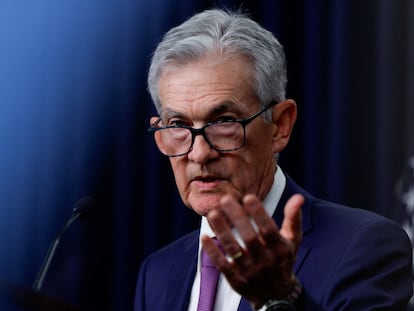US employers add a surprisingly strong 275,000 jobs in sign of continued economic strength
The unemployment rate was 3.9% in February. Though that marks the highest rate in two years, it was the 25th straight month in which joblessness has remained below 4%

America’s employers delivered another healthy month of hiring in February, adding a surprising 275,000 jobs and again showcasing the U.S. economy’s resilience in the face of high interest rates.
Last month’s job growth marked an increase from a revised gain of 229,000 jobs in January. At the same time, the unemployment rate ticked up two-tenths of a point in February to a still-low 3.9%. Though that marks the highest rate in two years, it was the 25th straight month in which joblessness has remained below 4%.
Friday’s report also drastically revised down the government’s estimate of hiring in December and January from what had been blockbuster increases to still-solid gains.
The jobs report also gave the inflation fighters at the Federal Reserve what could be a dose of encouraging news: Average hourly wages rose just 0.1% from January and 4.3% from a year earlier, less than economists had expected. Average pay growth has been exceeding inflation for more than year, but when it rises too fast it can feed inflation.
Friday’s figures reflected the job market’s sustained ability to withstand the 11 rate hikes the Fed imposed in its drive against inflation, which made borrowing much costlier for households and businesses. Employers have continued to hire briskly to meet steady demand from consumers across the economy.
Yet despite sharply lower inflation, a healthy job market and a record-high stock market, many Americans say they are unhappy with the state of the economy — a sentiment that is sure to weigh on President Joe Biden’s bid for re-election. Many voters blame Biden for the surge in consumer prices that began in 2021. Though inflationary pressures have significantly eased, average prices remain about 17% above where they stood three years ago.
When the Fed began aggressively raising rates in March 2022 to fight the worst bout of inflation in four decades, a painful recession was widely predicted, with waves of layoffs and high unemployment. The Fed boosted its benchmark rate to the highest level in more than two decades.
Inflation has eased, more or less steadily, in response: Consumer prices in January were up just 3.1% from a year earlier — way down from a year-over-year peak of 9.1% in 2022 and edging closer to the Fed’s 2% target.
Many Americans are exhibiting confidence in the economy through their actions: Consumers, whose average wages have outpaced inflation over the past year and who socked away money during the pandemic, have continued to spend and drive economic growth. The economy’s gross domestic product — the total output of goods and services — grew by a solid 2.5% last year, up from 1.9% in 2022. And employers keep hiring.
Immigration has helped invigorate the job market since the end of pandemic-related travel bans. Last year, foreign-born individuals accounted for 62%, or 1.5 million, of the 2.4 million people who either obtained a job or began looking for one. The economy’s growth depends on a steady influx of job seekers.
In the meantime, the job market’s modest slowdown is happening so far in perhaps the most painless way possible: Companies are posting slightly fewer job openings rather than laying people off. The number of Americans filing for weekly unemployment benefits — a rough proxy for the number of layoffs — has remained low, suggesting that most workers enjoy solid job security.
Wage growth still remains slightly high from the Fed’s perspective because it can contribute to inflation pressures. Some economists argue, though, that pay increases don’t need to drop so much: A surge in productivity that started last year — as companies invested in machines and used their workers more efficiently — means that employers can pay more and still reap profits without raising prices.
Sign up for our weekly newsletter to get more English-language news coverage from EL PAÍS USA Edition
Tu suscripción se está usando en otro dispositivo
¿Quieres añadir otro usuario a tu suscripción?
Si continúas leyendo en este dispositivo, no se podrá leer en el otro.
FlechaTu suscripción se está usando en otro dispositivo y solo puedes acceder a EL PAÍS desde un dispositivo a la vez.
Si quieres compartir tu cuenta, cambia tu suscripción a la modalidad Premium, así podrás añadir otro usuario. Cada uno accederá con su propia cuenta de email, lo que os permitirá personalizar vuestra experiencia en EL PAÍS.
¿Tienes una suscripción de empresa? Accede aquí para contratar más cuentas.
En el caso de no saber quién está usando tu cuenta, te recomendamos cambiar tu contraseña aquí.
Si decides continuar compartiendo tu cuenta, este mensaje se mostrará en tu dispositivo y en el de la otra persona que está usando tu cuenta de forma indefinida, afectando a tu experiencia de lectura. Puedes consultar aquí los términos y condiciones de la suscripción digital.
More information
Archived In
Últimas noticias
Welcome to the post-religion era: The idea of Christianity as the absolute truth has become obsolete
‘I thought you would like it’: The risky sexual practice popularized by TV shows and TikTok
The digitalization of tourism: ‘They promise experiences and gave us the worst possible one’
Mexican peso defies uncertainty with forecasts of a new period of stability in 2026
Most viewed
- Sinaloa Cartel war is taking its toll on Los Chapitos
- Reinhard Genzel, Nobel laureate in physics: ‘One-minute videos will never give you the truth’
- Oona Chaplin: ‘I told James Cameron that I was living in a treehouse and starting a permaculture project with a friend’
- Why the price of coffee has skyrocketed: from Brazilian plantations to specialty coffee houses
- Silver prices are going crazy: This is what’s fueling the rally










































